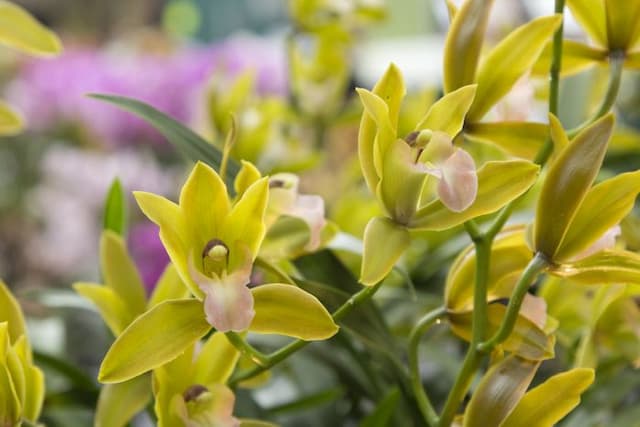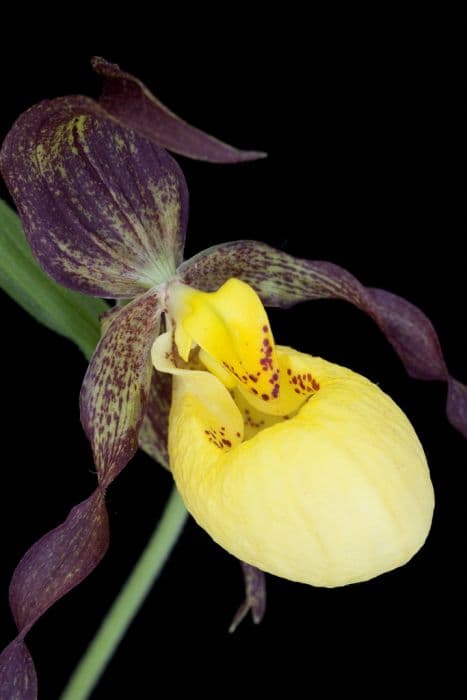Noble Dendrobium Dendrobium nobile

ABOUT
Dendrobium nobile, commonly known as the Noble Dendrobium, is an eye-catching orchid species with a striking appearance. The plant is characterized by its long, slender stems that branch out elegantly. These stems often have a somewhat bamboo-like look, both in terms of their segmented nature and the occasional leaf that sprouts from their nodes. The leaves of the Noble Dendrobium are a deep, rich green, and their shape is elongated, tending to curve gracefully. They have a smooth texture and are quite leathery to the touch. The foliage provides a lush backdrop for the plant's most spectacular feature - its blossoms. Flowers of the Noble Dendrobium are undoubtedly the stars of the show. They grow in clusters along the stem and can range in color from pure white to pale pink or even deep purple. Each blossom exhibits a symmetrical shape and boasts an attractive, waxy quality. The petals and sepals spread out from the center of the flower, framing the distinctive lip, which is often a contrasting color adorned with unique markings or patterns. The lip, a modified petal typical to orchids, serves as a landing pad for pollinators and can have various shapes and textures distinct from the rest of the flower. The blossoms of the Noble Dendrobium carry a pleasing fragrance and can bloom for several months under optimal conditions, providing a long-lasting display of floral beauty. The overall appearance of the plant is one of tropical elegance and vibrant life.
About this plant
 Names
NamesSynonyms
Noble Dendrobium, Noble Orchid
Common names
Callista nobilis, Dendrobium coerulescens, Dendrobium formosanum, Dendrobium lindleyanum, Dendrobium nobile var. album, Dendrobium wangliangii, Distichorchis nobilis.
 Toxicity
ToxicityTo humans
The Noble Dendrobium is generally not considered toxic to humans. It is commonly grown as an ornamental plant and there are no widespread reports of poisoning or toxic reactions in humans from handling or ingesting parts of the Noble Dendrobium. Therefore, accidental ingestion is not likely to cause harm beyond the potential for mild stomach upset.
To pets
The Noble Dendrobium is not known to be toxic to pets either. Like with humans, ingestion of this plant by pets is unlikely to lead to serious health problems. While it is always best to prevent pets from eating houseplants as a general precaution, the Noble Dendrobium does not pose a significant risk of toxicity to cats, dogs, or other household animals.
 Characteristics
CharacteristicsLife cycle
Perennials
Foliage type
Evergreen
Color of leaves
Green
Flower color
Varies
Height
1-2 feet (30-60 cm)
Spread
1-2 feet (30-60 cm)
Plant type
Orchid
Hardiness zones
10-11
Native area
Southeast Asia
Benefits
 General Benefits
General Benefits- Aesthetic Appeal: Dendrobium nobile, also known as the Noble Dendrobium, is prized for its striking and vibrant flowers, adding beauty and color to any environment.
- Enhances Mood: The presence of the Noble Dendrobium's flowers can have a positive impact on a person's mood, reducing stress and promoting happiness.
- Long Bloom Period: This orchid has a relatively long flowering period, which can last up to several months, providing prolonged enjoyment.
- Cultural Symbolism: In certain cultures, Dendrobium nobile is associated with sophistication and artistry, making it a meaningful gift or decorative element.
- Low Maintenance: Once an appropriate environment is established, the Noble Dendrobium requires minimal maintenance, which is ideal for busy plant enthusiasts.
- Hobby Cultivation: Growing and caring for Dendrobium nobile can be a rewarding hobby for orchid enthusiasts, offering the opportunity to learn and practice cultivation techniques.
- Space Efficiency: Being an epiphytic plant, Dendrobium nobile does not require much space and can be mounted on various supports, making it suitable for small living areas.
 Medical Properties
Medical Properties- Anti-inflammatory properties: Dendrobium nobile has been used in traditional medicine to reduce inflammation.
- Analgesic effects: It may have pain-relieving properties.
- Immune system enhancement: There are indications that it might boost the immune system.
- Antioxidant activity: The plant contains compounds that can help protect the body from oxidative damage.
- Antipyretic properties: It has been traditionally used to reduce fever.
- Hydration: It may help to replenish fluids and restore electrolyte balance.
 Air-purifying Qualities
Air-purifying QualitiesThis plant is not specifically known for air purifying qualities.
 Other Uses
Other Uses- Ornamental Display: Dendrobium nobile, commonly known as the Noble Dendrobium, is often grown for its striking flowers and is used as a decorative element in homes and public spaces.
- Jewelry Making: The flowers of the Noble Dendrobium can be used to create organic, biodegradable jewelry, such as earrings and necklaces, for a natural aesthetic.
- Photography Subjects: The plant's vivid blooms are popular subjects for photographers, especially those specializing in macro and nature photography.
- Gift Plants: Due to their beauty and perceived sophistication, Noble Dendrobium orchids are given as gifts for special occasions like anniversaries and housewarmings.
- Floral Arrangements: Florists use the striking Noble Dendrobium flowers to create exotic and long-lasting arrangements.
- Educational Model: This plant is used in botanical education to demonstrate the lifecycle of orchids and the diversity of the Orchidaceae family.
- Perfumery: Although not as common, the scent of some Noble Dendrobium flowers could be used to create delicate and unique fragrances.
- Religious and Cultural Symbolism: In some cultures, Dendrobium nobile is used in religious rituals and ceremonies as a symbol of purity.
- Fine Art Inspiration: Artists may use the organic forms and colors of the Noble Dendrobium as inspiration for paintings, drawings, and sculptures.
- Cooking: In some gourmet dishes, the edible flowers of the Noble Dendrobium are used as a unique and elegant garnish.
Interesting Facts
 Feng Shui
Feng ShuiThe Dendrobium Orchid is not used in Feng Shui practice.
 Zodiac Sign Compitability
Zodiac Sign CompitabilityThe Dendrobium Orchid is not used in astrology practice.
 Plant Symbolism
Plant Symbolism- Beauty: The Dendrobium nobile, commonly known as the Noble Dendrobium, often symbolizes beauty due to its elegant and vibrant flowers that captivate onlookers.
- Refinement: This orchid is associated with sophistication and refinement, reflecting the delicate and graceful aspects of its appearance.
- Purity: With its pristine and clean look, the Noble Dendrobium is often related to the concept of purity and innocence.
- Life and Vitality: As an orchid that thrives under careful attention, it represents life and vitality, highlighting the plant's resilience and the energy it brings to its environment.
- Fertility: In some cultures, orchids are seen as symbols of fertility due to their shape and the abundance of seeds they produce.
 Water
WaterNoble Dendrobium orchids should be watered once every week to ten days, allowing the potting medium to dry out slightly between waterings. Apply enough water to see it run freely from the bottom of the pot, ensuring thorough saturation of the potting medium. Depending on the size of the pot, this might be equivalent to about 8 to 16 ounces of water per watering session. During the active growth phase in spring and summer, watering frequency may increase due to higher light and temperature conditions, but always check the moisture level before watering.
 Light
LightNoble Dendrobium orchids thrive in bright, indirect light conditions. They should be placed in an east or west-facing window where they receive some direct sun during the morning or late afternoon. Avoid direct midday sun, which can be too intense and may scorch the leaves. If natural light is insufficient, supplement with grow lights to mimic the orchid's preferred lighting conditions.
 Temperature
TemperatureNoble Dendrobium orchids prefer temperatures ranging from 50 to 70 degrees Fahrenheit at night, with a daytime range of 60 to 85 degrees Fahrenheit. They can tolerate temperatures as high as 95 degrees Fahrenheit if shading and increased humidity are provided. It's essential to avoid exposure to temperatures below 50 degrees Fahrenheit as these can be detrimental to the plant's health.
 Pruning
PruningPrune Noble Dendrobium orchids to remove spent flower stems and to maintain plant shape. Pruning should be done after the orchid has finished blooming, typically in the late winter or early spring. Cut back the flower stalks to the base of the plant using sterile pruning shears. It is also a good practice to remove any dead or yellowing leaves to ensure the plant's energy is directed towards new growth.
 Cleaning
CleaningAs needed
 Soil
SoilThe Noble Dendrobium orchid thrives in a well-draining, orchid-specific mix composed of bark, charcoal, and perlite. The ideal soil pH for Dendrobium nobile should be slightly acidic to neutral, in the range of 5.5 to 7.0. Regularly inspect for decomposition and refresh the mix to prevent waterlogging.
 Repotting
RepottingNoble Dendrobium orchids should be repotted every 2 to 3 years, preferably in the spring after flowering. Choose a pot only slightly larger than the previous one to avoid excess moisture retention which can lead to root rot.
 Humidity & Misting
Humidity & MistingNoble Dendrobium orchids prefer high humidity, ideally between 50-70%. Consistent higher humidity is crucial for their growth, bearing in mind adequate air circulation to prevent diseases.
 Suitable locations
Suitable locationsIndoor
Place Noble Dendrobium in bright light, away from direct sun, ensure high humidity and good airflow.
Outdoor
Provide dappled light, protect from intense sun and frost, ensure high humidity levels.
Hardiness zone
10-11 USDA
 Life cycle
Life cycleThe life of the Dendrobium nobile, commonly known as the Noble Dendrobium orchid, begins with the germination of tiny seeds that require a symbiotic relationship with a mycorrhizal fungus to provide the necessary nutrients. Following germination, the plant develops a protocorm, which is an intermediary organ between seed and seedling, eventually giving rise to the first leaves and roots. As the orchid matures, it forms pseudobulbs, which are swollen stems that serve as storage organs for water and nutrients, essential for the plant's growth and flowering. The orchid reaches maturity and enters its flowering stage, blooming with a spectacular array of flowers that can last several weeks to months. After pollination, which is often facilitated by insects, the flowers develop into fruiting capsules containing numerous dust-like seeds, thereby completing the reproductive cycle. Finally, the plant may enter a period of dormancy, particularly in cooler climates, during which growth slows down or ceases until conditions become favorable again.
 Propogation
PropogationPropogation time
Spring-Early Summer
Propogation: The most popular method of propagation for Dendrobium nobile, commonly known as the Noble Dendrobium, is through division. This process is typically done in the spring, just after the plant has finished flowering, when the plant is starting to produce new growth. To propagate by division, carefully remove the plant from its container and gently separate the pseudobulbs, ensuring that each division has at least one healthy cane and a good root system. After the division, the cut surfaces should be treated with a fungicide to prevent infection. Then, pot each division into a suitable orchid potting mix, ideally in small pots that snugly fit the size of the roots, which allows for better control of moisture. It's important to maintain high humidity and consistent watering after repotting to encourage new growth and help the divisions establish.









